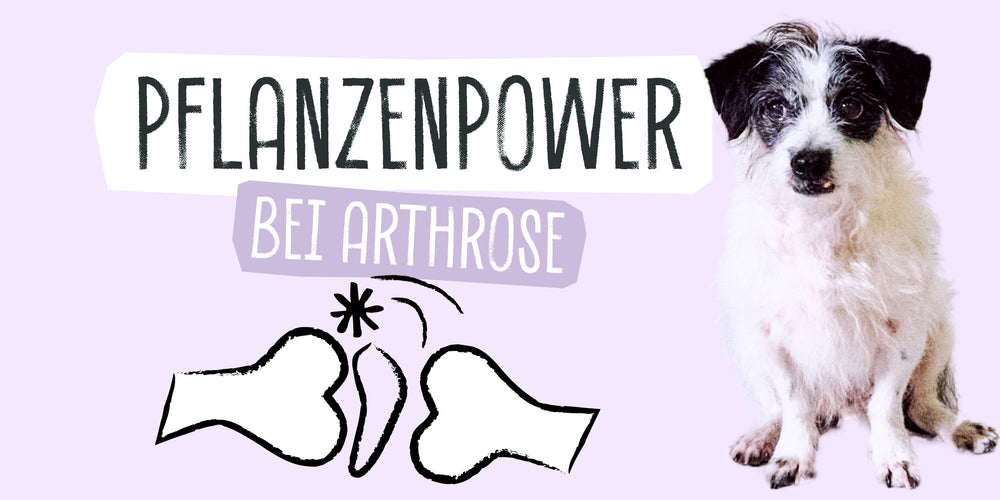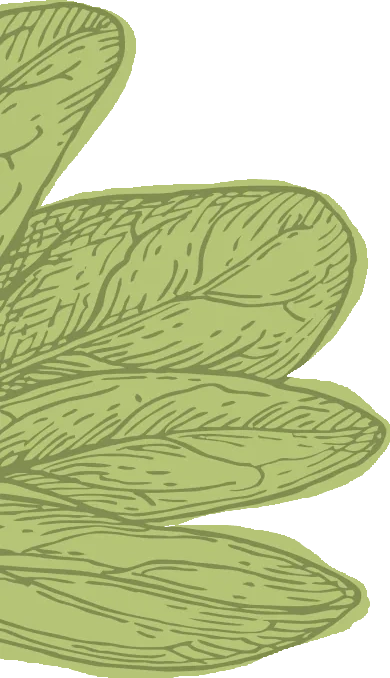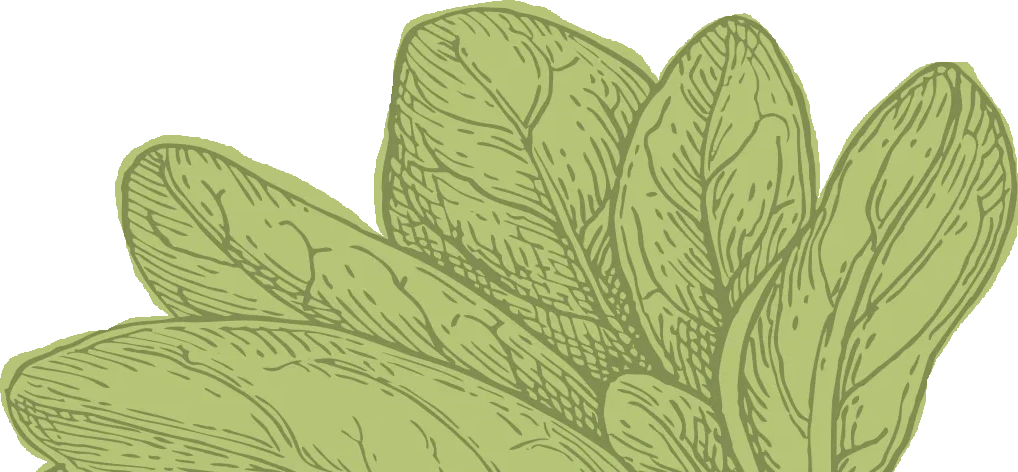
Osteoarthritis in dogs: The right diet for healthy joints
Does your furry friend move stiffly after a nap or have difficulty getting up? These could be the typical symptoms of osteoarthritis, the most common joint disease in dogs.
 Author: Carla Steffen
Author: Carla Steffen
 Proofreader: Veronika Hajek
Proofreader: Veronika Hajek
Updated: 01.10.2024
Published: 29.04.2024
Is your furry friend stiff after a nap or has difficulty getting up? These can be typical symptoms of osteoarthritis, the most common joint disease in dogs.
Often, osteoarthritis begins gradually and progresses throughout a dog's life. If you notice the first signs, you should act immediately, because at this point there are often already small changes in the joint that do not go away. This can lead to severe pain, which is why a visit to the veterinarian's office for an accurate diagnosis is always a good idea.
But don't worry: many dogs live happily and contentedly with mild arthritis. By taking measures such as adjusting their diet, you can slow down the progression of arthritis and help your dog to remain mobile and as pain-free as possible.
A special diet to relieve osteoarthritis is even possible if it is completely vegan. You can use a range of herbal supplements that have a positive effect on the health of your dog's joints and can counteract the inflammatory reactions. And it gets even better: There is no scientific evidence that dietary products of animal origin are more effective for treating osteoarthritis than plant-based ones.
Let’s take a look at what nature has to offer to prevent osteoarthritis and reduce the resulting symptoms.
Recognizing and interpreting symptoms
Osteoarthritis often develops slowly and the early signs are often overlooked. In addition to lameness, reduced joint mobility and a significant decrease in activity may also occur as the pain restricts movement. This can lead to muscle breakdown, which in turn can cause tension and further pain. Advanced osteoarthritis can cause hardening of bones, ligaments and cartilage, particularly in commonly affected areas such as the knees, shoulders, hips and elbows. However, osteoarthritis can also occur in the paws or spine.
Herbal home remedies for treating pain and inflammation
turmeric
Turmeric is a ginger plant from South Asia and contains the compound curcumin, which has antioxidant and anti-inflammatory effects (Oliveira et al., 2015). In a study in which 18 dogs with osteoarthritis received turmeric at a dose of 6.60 mg/kg body weight for 60 days, the anti-inflammatory activity of curcumin was confirmed (Scorlon et al. 2016). These results are consistent with those of Colitti et al. (2012).
Salai tree
The Salai tree is a tree from India whose resin is used for medicinal purposes.
Studies showed that Boswellia resin administered to dogs for 6 weeks helped reduce lameness (during exercise or after a long rest), local pain, and stiff gait (Comblain et al., 2016).
field horsetail
Field horsetail can even be found in our local meadows and has long been considered a medicinal plant. Its anti-inflammatory effect was described, for example, by Gründemann et al. (2014).
Please note that you should not simply harvest horsetail from the meadow to feed it to your dog. The horsetail must first be processed and tested for harmlessness, for example, due to contamination with pesticides or other plants that are poisonous to dogs. Therefore, please always purchase a preparation that has been specially developed for dogs.
devil's claw
Devil's Claw is a South African plant that contains harpagoside as one of its main biologically active phytochemical compounds.
A number of studies support the effectiveness of harpagoside in relieving the symptoms of osteoarthritis (see, for example, Gagnier et al., 2004). An herbal supplement containing devil's claw demonstrated its anti-inflammatory effects in a study with dogs (Moreau et al., 2014).
omega-3 fatty acids
Omega-3 fatty acids are essential for the dog's body and perform important functions in the organism. The most important plant-based food sources for omega-3 fatty acids are micro-algae and vegetable cooking oils such as linseed oil.
Studies have shown that taking omega-3 fatty acids improves the condition of dogs with osteoarthritis (Roush et al., 2010). In a study comparing the omega-3 fatty acids EPA and DHA (which can be obtained from algae, see Winwood, 2013) and α-linolenic acid (found in vegetable oils) in terms of their effect on cartilage degradation and joint inflammation, EPA was found to be the most effective omega-3 fatty acid (Hurst et al., 2010). The best plant-based source of EPA is algae oil from the microalgae Schizochytrium.
Our VISH OIL contains a lot of omega-3 fatty acids and therefore EPA and DHA. This makes it ideal for dogs with arthritis. We also offer it in our Pionierbox Senior with our SENIOR wet food at a special price.
glucosamine
Glucosamine is an amino sugar that is conventionally extracted from shellfish. Recent studies use microbial fermentation by filamentous fungi or recombinant Escherichia coli as an alternative method for producing glucosamine. This method also showed a significant improvement in the pain of dogs with osteoarthritis when given glucosamine (Lowe, 2020). VEGDOG's MOBILITIES contain glucosamine, making them a healthy and joint-supporting snack for your furry friend.
CBD oil
CBD oil is extracted from hemp and contains the active ingredient "cannabidiol" (CBD) in concentrated form, which is known for its anti-inflammatory properties . A study also found that CBD oil had a positive effect on the joy of movement in osteoarthritis (Gamble Lauri-Jo, 2018). There is no need to worry about an intoxicating effect - the substance in hemp responsible for this, "tetrahydrocannabinol" (THC), is removed during the production of CBD oil.
By the way: Our VEGGIES SKINCARE contains valuable hemp.
Conclusion on herbal home remedies
As you can see, there are good herbal supplements available to support the treatment of osteoarthritis in dogs.
But be careful: plant-based products should not be fed indiscriminately. Some should only be given as a cure, while others are suitable for long-term therapy. Interactions with other foods must also be checked.
It is best to seek veterinary advice – now you are well informed about the vegan options.
It is also important to remember that these herbal remedies are only supportive and will not completely eliminate pain from osteoarthritis, let alone cure it (which is not possible). It is therefore extremely important to start additional pain therapy if necessary and to arrange regular veterinary check-ups.
5 Measures to Prevent Osteoarthritis
- The right diet against obesity
Being overweight damages the joints of our four-legged friends and can therefore promote arthritis. A rule of thumb is that a furry friend's ribs should not be visible, but should be noticeable. - Individual movement on a joint-friendly surface
Soft ground is also easier on the joints than walking on hard asphalt, which promotes joint wear. - To swim
Swimming supports muscle building without causing joint wear. Swimming is therefore often recommended for dogs who already suffer from arthritis to counteract muscle loss. - Support for stairs, cars or high bed edges
Dogs are able to jump into a car or walk up the stairs on their own, but this is not always advisable above a certain height difference. Overloading of the joints can be prevented by installing climbing aids or ramps, for example, which the furry friend can then use. - Healthy eating
As already mentioned, nutrition is crucial for supporting joint metabolism. Therefore, attention should be paid to the right dog food for the joints
bibliography
Colitti, M., Gaspardo, B., Della Pria, A., Scaini, C., Stefanon, B., 2012. Transcriptome modification of white blood cells after dietary administration of curcumin and non-steroidal anti-inflammatory drug in osteoarthritic affected dogs. Vet. Immunol. Immunopathol.147, 136–146
Comblain, F., Serisier, S., Barthelemy, N., Balligand, M., & Henrotin, Y. (2016). Review of dietary supplements for the management of osteoarthritis in dogs in studies from 2004 to 2014. Journal of veterinary pharmacology and therapeutics, 39(1), 1-15.
Gründermann, C., Lengen, K., Sauer, B., Garcia-Kaufer, M., Zehl, M., & Huber, R. (2014). Equisetum arvense (common horsetail) modulates the function of inflammatory immunocompetent cells. BMC complementary and alternative medicine, 14(1), 1-10.
Hurst, S., Zainal, Z., Caterson, B., Hughes, C.E., & Harwood, J.L. (2010). Dietary fatty acids and arthritis. Prostaglandins, Leukotrienes and Essential Fatty Acids (PLEFA), 82(4-6), 315-318.
Lowe, R. J. (2020). Evidence for the use of supplements in canine arthritis management. Veterinary Nursing Journal, 35(9-12), 353-357.
Moreau, M., Lussier, B., Pelletier, JP, Martel-Pelletier, J., Bédard, C., Gauvin, D., & Troncy, E. (2014). A medicinal herb-based natural health product improves the condition of a canine natural osteoarthritis model: a randomized placebo-controlled trial. Research in veterinary science, 97(3), 574-581.
Oliveira, A.S., Sousa, E., Helena Vasconcelos, M., & Pinto, M. (2015). Curcumin: a natural lead for potential new drug candidates. Current medicinal chemistry, 22(36), 4196-4232.
Roush, JK, Dodd, CE, Fritsch, DA, Allen, TA, Jewell, DE, Schoenherr, WD, … & Hahn, KA (2010). Multicenter veterinary practice assessment of the effects of omega-3 fatty acids on osteoarthritis in dogs. Journal of the American Veterinary Medical Association, 236(1), 59-66.
Sgorlon, S., Stefanon, B., Sandri, M., & Colitti, M. (2016). Nutrigenomic activity of plant derived compounds in health and disease: Results of a dietary intervention study in dogs. Research in veterinary science, 109, 142-148.
Shoba, G., Joy, D., Joseph, T., Majeed, M., Rajendran, R., & Srinivas, PSSR (1998). Influence of piperine on the pharmacokinetics of curcumin in animals and human volunteers. Planta medica, 64, 353-356.
Winwood, R. J. (2013). Recent developments in the commercial production of DHA and EPA rich oils from micro-algae. Ocl, 20(6), D604.
Gamble Lauri-Jo, Boesch Jordyn M, Frye Christopher W, Schwark Wayne S, et al. (2018). Pharmacokinetics, Safety, and Clinical Efficacy of Cannabidiol Treatment in Osteoarthritic Dogs. Frontiers in Veterinary Science, 5, 165
Frequently Asked Questions (FAQ)
How much exercise should a dog with osteoarthritis get?
Dogs with arthritis need more time to run and therefore cannot run at the same speed as other healthy dogs. However, exercise should not be avoided in order to counteract muscle loss. Swimming is therefore a good form of exercise that is gentle on the joints.
What is the best way to deal with a dog suffering from arthritis?
A healthy diet, exercise and, if necessary, medication are the way to a happy life for your pet with arthritis. This counteracts muscle loss and can alleviate pain.
What should I not feed my dog with arthritis?
A healthy diet is essential for osteoarthritis. The food should be high quality, easy to digest and rich in healthy fats such as omega 3 and 6 fatty acids. You should not give your dog too much to eat, as every extra kilo puts a strain on the musculoskeletal system. A vegan diet is therefore a very good option.








